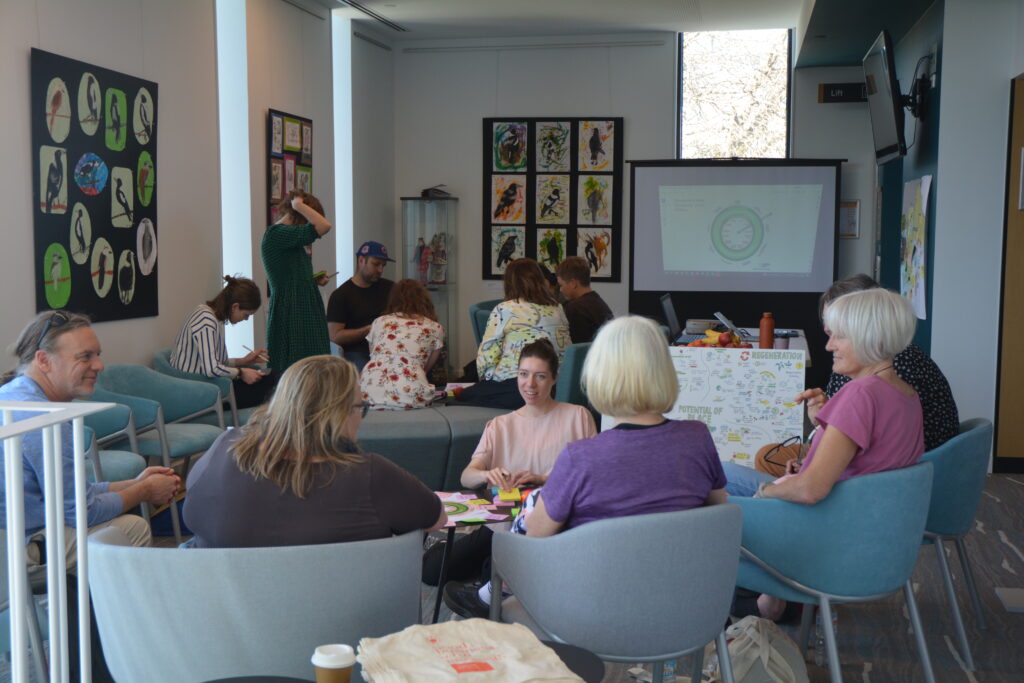
REGEN GIPPSLAND IS A PLATFORM FOR AMBITIOUS COLLABORATION IN SERVICE TO OUR REGION. POWERED BY A GROWING ALLIANCE OF ORGANISATIONS.
There are many groups in Gippsland working in their respective fields to help make Gippsland a better place – groups that have an exciting vision and enthusiastic members. While such a group can achieve certain goals in its particular sector, imagine how much more can be gained for Gippsland as a whole if these groups work collaboratively.
Initial public engagement took place in November 2022 at Warragul Goods Shed where we came together to start co-creating a vision for a regenerative future for Gippsland.
This two-day Local Learning Lab was instrumental in collectively laying the foundations for Regen Gippsland. Through the co-design process, in the lead-up, and over the weekend the concept was explored in depth and the groundwork laid.
The proposal for a six month pilot was developed from insights surfaced at the Lab with seed funding provided by WWF-Australia and Kindred Spirits Enterprises to progress.
Since then, a crucial focus has been on channeling the collective energy of the Gippsland community to co-create a resilient vision and purpose for guiding Regen Gippsland.
More than 100 Gippslandians generously volunteered their time, contributing to this collaborative effort through various avenues such as the Local Learning Lab, three engaging Community Co-design Forums, a strategy day, and casual chats with many individuals
This inclusive process underscores the heart of our community-driven approach, ensuring that the vision reflects the diverse voices and aspirations.
At the core of our community engagement process were three community design forums, each covering a particular emerging theme in relation to the place;
- Regen Tourism in East Gippsland
- Food & Fibre in West Gippsland
- New Energy in South Gippsland
These workshops each addressed the opportunity and aspirations of place, acknowledged existing local initiatives and champions, and explored the theme in relation to the Doughnut. A key aspiration from our community forums was to introduce the concept of Doughnut Economics and explore how it could be localised and used as a compass for Gippsland.
Insights from the pilot have been used to create our first version of the Gippsland Doughnut. Following the conclusion of the pilot, Kindred Spirits Enterprises agreed to auspice Regen Gippsland for 12 months.
The story here represents an initial, modest endeavour to apply Doughnut Economics in addressing significant challenges and opportunities for Gippsland. What was evident in our engagement phase was that to enable
our transition to a regenerative economy requires ambitious cross-sector collaboration between governments, businesses, communities and individuals.
This marks just the beginning of our collective journey towards a regenerative Gippsland. We invite all Gippslandians to engage and
participate in shaping a future for our region that thrives within the boundaries of the Doughnut.
Regen Gippsland aims to amplify and expedite these endeavours, by channelling the collective power of the alliance to enable the transition to a future that better serves people and the planet.
The Regen Gippsland vision

Our goal
Regen Gippsland aims to channel the collective power of the alliance to enable the transition to a future that better serves people and the planet.
How we’re involved
As the auspicing organisation, Kindred Spirits Enterprises assists with project coordination (administration, governance and strategic planning), advocacy, funding and stakeholder relations.
What is doughnut economics?
Doughnut Economics is a concept and economic model
introduced by economist Kate Raworth. It offers an alternative
framework for economic development that seeks to balance
human well-being with ecological sustainability. The model
envisions an economic “doughnut” shape, where the inner ring
represents the social foundation, ensuring that all people have
access to essentials such as food, healthcare, and education,
without falling into poverty. Meanwhile, the outer ring
represents the ecological ceiling, defining the environmental
limits beyond which human activities risk causing irreversible
damage to the planet.
The goal of Doughnut Economics is to find a balance between
meeting the basic needs of all individuals and staying within
the ecological boundaries of the Earth. It encourages a shift
from the traditional growth-centric economic approach to one
that prioritizes sustainability, social justice, and well-being. The
model has gained attention as a tool for rethinking economic
policies and practices to create a more inclusive and
environmentally sustainable future.




